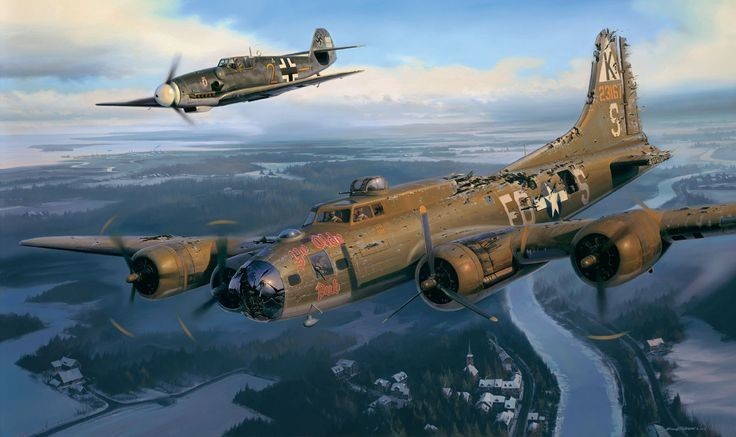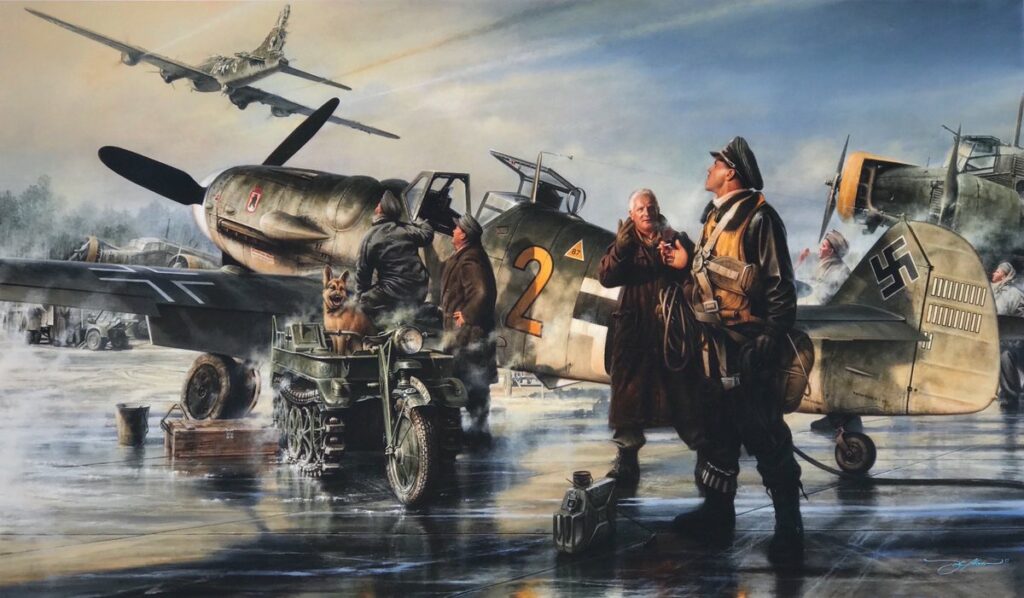
From Enemies to Friendship
December 20, 1943 A few days before Christmas and snowlakes spattered the windshield of “Ye Olde Pub”. An American B-17 bomber, flying 20,000 feet above the North Sea. It’s part of an 8 mile long bomber stream on its way to Northern Germany. Their target is a Fockewulf aircraft factory in the city of Bremen.
Piloting a Flying Fortress as the B-17’s are known for the first time is Charlie Brown who has the lives of 10 young men of 379 Bombardment Group in his hands. During the month, the Americans had dropped over 2.6 million pounds of bomb on German industrial and military targets. Charlie Brown and his team were ready to launch their 12500 pound bombs.
Shortly after 11:00 in the morning, they crossed the German border nervously on the lookout for enemy fighters. Because if they can see Germany so too can the German spotters see them and calculate their height, speed and intended destination. Covering them as escourts where American P-47 Thunderbolts whose job was to intercept the enemy.
At 11:30, it was covered with anti-aircraft fire. There were explosions in every direction, black clouds of smoke restricted the view. Charlie Brown could barely see a thing through the smoke. Suddenly a red flash explodes right before his eyes. The plexiglass nose of the plane was sheared off and smashed against the windshield. The men up front were unhurt, but ice cold winds stream through the plane. The outside air temperature was -60 Celsius.
Minutes later, another red flash rocked the plane. Now engine number two was dead. Immediately afterwards, engine 4 on the right side was damaged and its propeller began to spin wildly out of control. As Charlie Brown tried to control his plane, a shell riped through the roof. Charlie’s main focus though was to keep the plane straight as the command to drop the bombs comed over through the radio.
Soon they dropped their bombs on the city of Bremen, where smoke rises on the orders from their radios. It was time to head home. Bomber formation turned back towards the North Sea. However, the danger hadn’t passed, they were still over the enemy territory. Charlie’s crew frantically scan the sky for enemy fighters.
There were no planes around. There were no enemies. At the same time, their fleet did not appear around. Charlie’s plane had only two engines running and was left behind in the flight formation. The copilot suddenly shouted. Fockewulf 190s appeared on the horizon. A group of Messerschmitt Bf109 immediately followed.
Charlie Brown was flying at full speed on his fighter squadron in order to reduce the target. The Fw-190s targeted the cockpit and started firing. The B-17’s “onboard gunman” managed to drop one of the planes. Another Fw-190 was shot by the “nose gunner” while maneuvering to avoid colliding with Charlie’s plane.
Immediately behind them Bf09 s approaching. The “tail gunner” was ready to fire. But the weapons did not work. It was frozen in -60 degrees cold. Gunman warned Charlie Brown and the B-17 took a major dive to avoid the attack. They were approaching the ground under a rain of bullets. His radios were damaged, the crew had injuries, and the tail gunner was dead.
The young pilot was just trying to keep his plane up. They had only one working weapon left. Charlie’s oxygen tank was damaged by a new attack on the cockpit. “Ye Olde Pub” lay uncontrollably to the left and the circles began to draw. The pilots were trying to regain control, but they failed. Charlie passed out.
Near Oldenburg, the plane was so low that Charlie recovered when oxygen reached normal levels. He immediately hugged the controls. He took the plane out of the dive at a height of about 1000 meters and managed to stabilize its height. Most of his team was injured and unconscious. The rest of the B-17 could fly at a speed of approximately 200 km. They would have to cross the German lines of defense on their way home.
Charlie could try to land the plane and become a prisoner of war with his crew, or they would continue to fly home, hoping not to fall apart. His teammates, who were still himself, refused to be enslaved and decided to try to go back together. At that time they were flying over a German airport.
German ace pilot Franz Stigler about to start the engine of his plane just below them. He shot a B-17 the day before, and if he did another, he’d be awarded the Knight’s Cross. For Franz, this award was proof that he did his job well and he is a good pilot…

Franz witnessed the bombers doing to Hamburg and Bremen. Yet he did not see his work as vengeance. What he did was to do his duty and he was trying to survive. He was aware of what war had taken from people. He lost a brother in battle. He was on the African and Italian fronts.
He took his plane off the ground. He placed his fingers on the trigger and stared at the enemy aircraft before starting his attack. He didn’t shoot. Something stopped him. When he approached, there was no fire from the B-17. He got closer to the bomber. He couldn’t believe his eyes when he saw the situation. It was a miracle he could fly. His only operable weapon seemed to be a cannon under the hull, but he couldn’t fire enough to hurt Stigler.
Franz Stigler saw that the tail gunman was out of place. The tail was almost completely torn. With only a few accurate shots, the German pilot could shoot down the plane and win a small victory over the unprotected men. There was something wrong with it.
He brought his plane closer to the B-17’s cockpit.
Charlie was waiting for the next plane-to-plane shooting, locked in the horizon. Suddenly he noticed Messerschmit Bf-109, which appeared on his right side. He closed his eyes and waited to wake up from his nightmare. When he opened his eyes again, the enemy fighter was still there.

Franz shook his finger and signaled that they should come down. Charlie shook his head. Franz Stigler knew that the plane had no chance. If they didn’t help them, they wouldn’t be able to go back.
The Bf-109 was flying with the injured B-17, traveling together to the Atlantic. They were in a position to see German anti-aircraft guns. The two enemy aircraft were side by side and no anti-aircraft shots were fired from the land.
Charlie didn’t understand what the enemy was trying to do until he came to the open sea. When they reached the safe zone, Franz Stigler greeted Charlie Brown and walked away to return to his base. The young B-17 pilot realized what had happened.
Ye Olde Pub managed to return to England, even if it was difficult. Commanders who survive the team preparing to give medals to learn the event experienced by the top management of the event will certainly be closed, he said. There was no such task and these events never happened. It should never be heard that a German pilot helped the enemy bomber.
Franz Stigler returned to his base successfully, but he could not tell anyone about the incident. If someone found out, that would mean his trial, and he’d probably be executed for what he did.
For years this event remained a secret between the two pilots. Until, in 1985, Boeing invited former fighter pilots to celebrate the 50th anniversary of the B-17. Franz Stigler lived in Vancouver Canada at the time and was the only German fighter pilot among those invited. A local TV station interviewed him, and Franz told him about the incident he had never crossed his mind.
In the same year, Charlie Brown wrote to a former German aces pilot Adolf Galland and a magazine. He wanted to find out who was the German pilot who saved their lives.
After years of correspondence and search, Franz and Charlie found each other in 1990. From 1990 to 2008 they became close friends.
Franz Stigler died on 22 March 2008 (92 years old) and Charlie Brown died 8 months later, on 25 November 2008 (86 years old).
Franz Stigler says:
“I wasn’t heartless enough to kill those brave men. I flew with them for a long time. They were trying to get home in a terrible state, and I was going to let them do it. I couldn’t shoot them.”

Be the first to comment